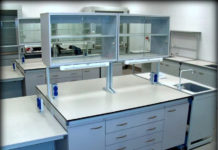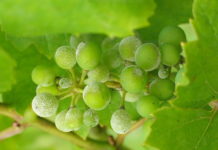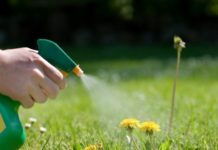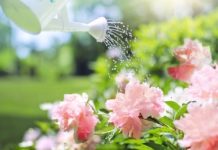Having a greenhouse made from indoor plants at home is not only beautiful, it has a beneficial effect on the surrounding atmosphere. After all, plants are able to purify the air by converting carbon dioxide into oxygen. But how to get this "filter" in the house if there is little light and there is absolutely no time to create a microclimate? In such a situation, preference should be given to shade-loving and unpretentious subspecies of ornamental plants. They have advantages:
- They give maximum oxygen in dark places, some species are only able to filter the air at night. Perfect for the bedroom.
- Do not require frequent watering and feeding.
- There is no need to create a special microclimate.
There are a large number of subspecies of shade-loving plants, this article will help you make a choice - it will tell you about popular plants, their advantages and disadvantages, and how to avoid mistakes when choosing.
Content
Low flowering, non-flowering
Bordered, Draco
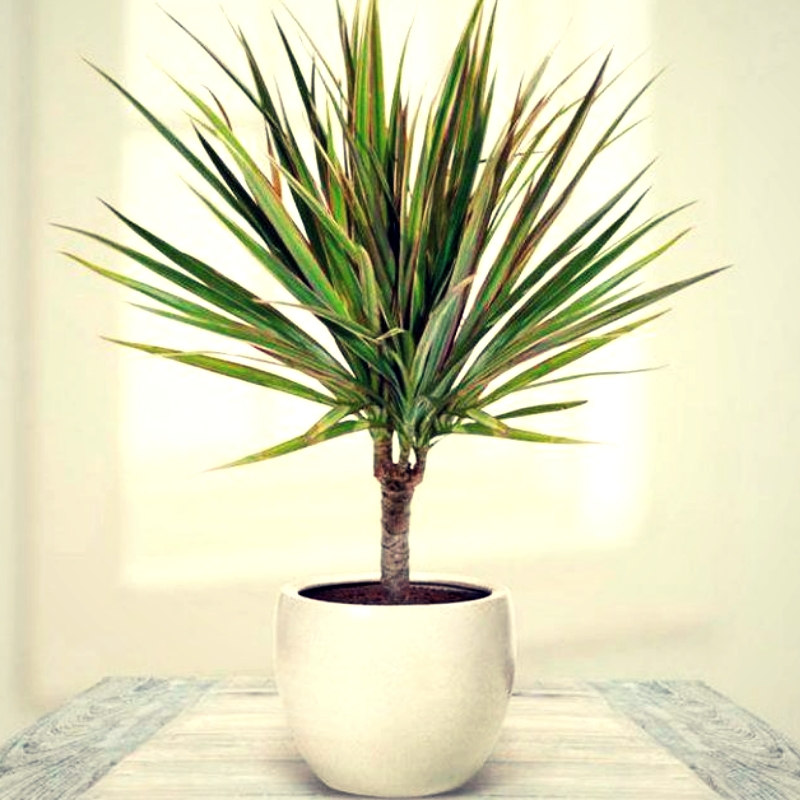
These are dracaena varieties that are distinguished by their beauty and are not capricious to the conditions of existence. They can be kept in the darkest corners of the apartment.
Dracaena can be found in many offices and institutions, attracted by its exotic appearance and unpretentiousness.
In favorable conditions it can grow up to 5 meters in height. Artificial lighting is good for plant development.
Benefits:
- water no more than once a week;
- the transplant is carried out once a year;
- no feeding is required.
Disadvantage:
- in dark corners practically does not bloom.
Sansevieria
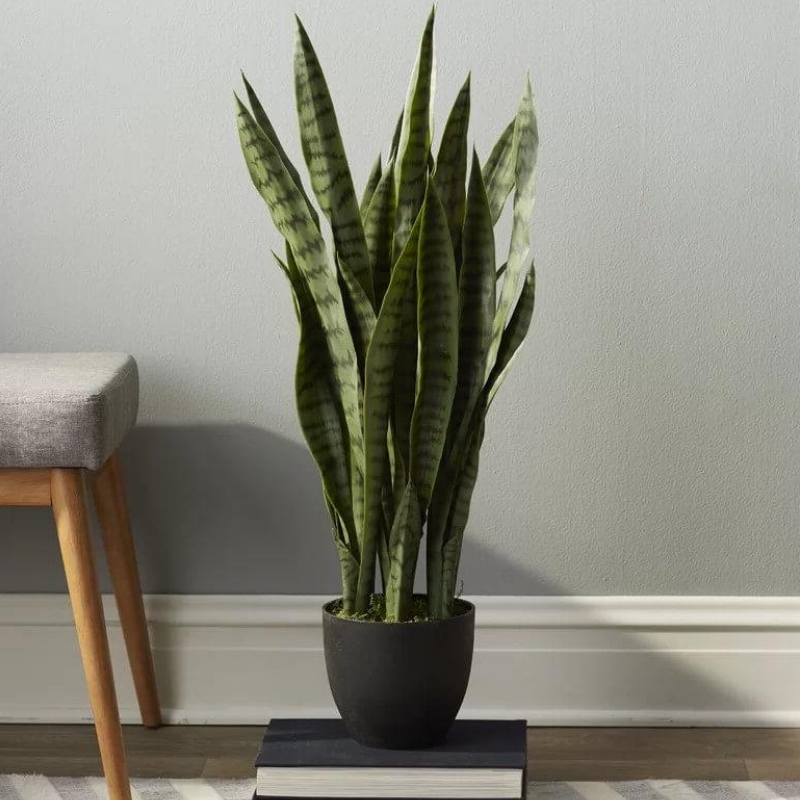
It is better to start with this species for those who are just trying to make friends with houseplants. Sansevieria grows well in any conditions. Drought or humidity tolerates easily. The plant rarely picks up color, but if optimal conditions are maintained without fluctuations, flower buds can be found.
Care is simple:
- watering once every 7-9 days;
- irrigation of foliage only in hot weather;
- fertilizing the soil every 6 months;
- the transplant is carried out after overgrowth.
Benefits:
- loves translucent places;
- grows well at temperatures above 14 degrees;
- give maximum oxygen.
Disadvantages:
- additional lighting is required in winter;
- does not like drafts.
Hibiscus
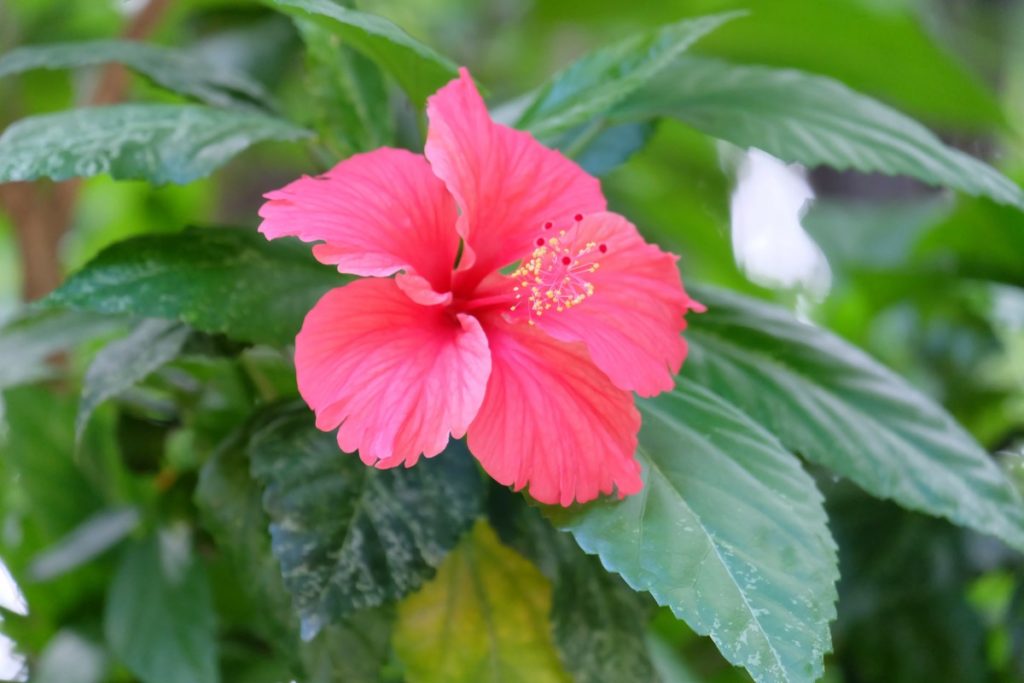
Everyone's favorite Chinese rose with large beautiful buds. Such a plant serves not only as a decoration for the house, but is used in the treatment of many diseases. Hibiscus leaves contain a large list of vitamins.
Benefits:
- fertilizing the soil no more than 1 time in 4-5 weeks;
- you can completely exclude fertilizers, but the plant will not bloom.
Disadvantages:
- mandatory placement with little light access;
- moistening the soil every 7-9 days;
- it is imperative to create a special microclimate.
Japanese fatsia
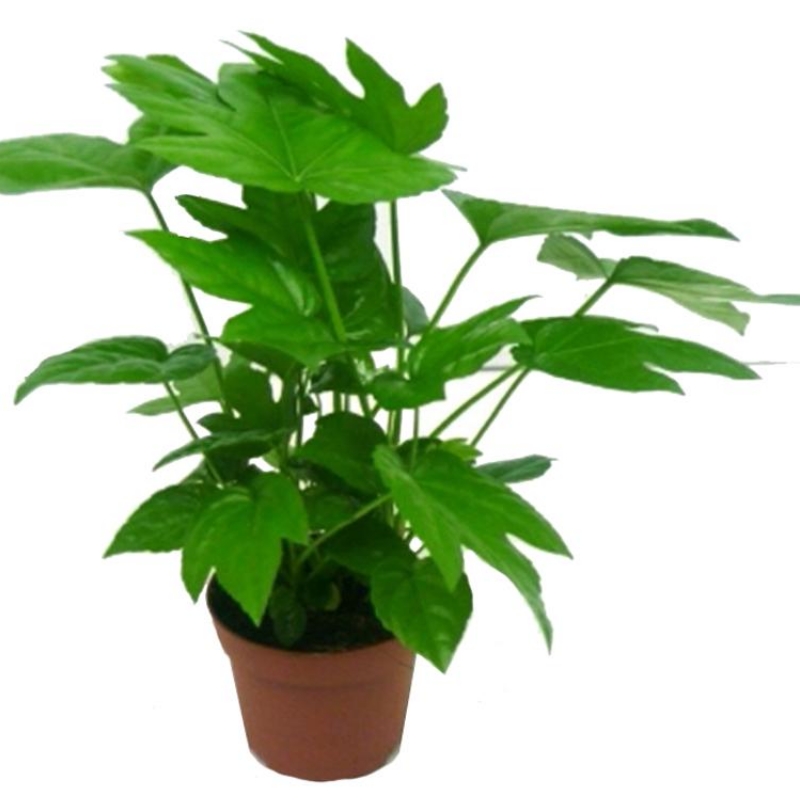
The plant does not require the creation of certain climatic conditions, loves the darkest corners of the room and even grows well near heating appliances.The flower is perfect for the bedroom, since flower growers claim that fatsia has a beneficial effect on sleep.
Benefits:
- humidifies the air;
- low probability of being infected with parasites and infection with any disease.
Disadvantages:
- Not identified.
Geranium
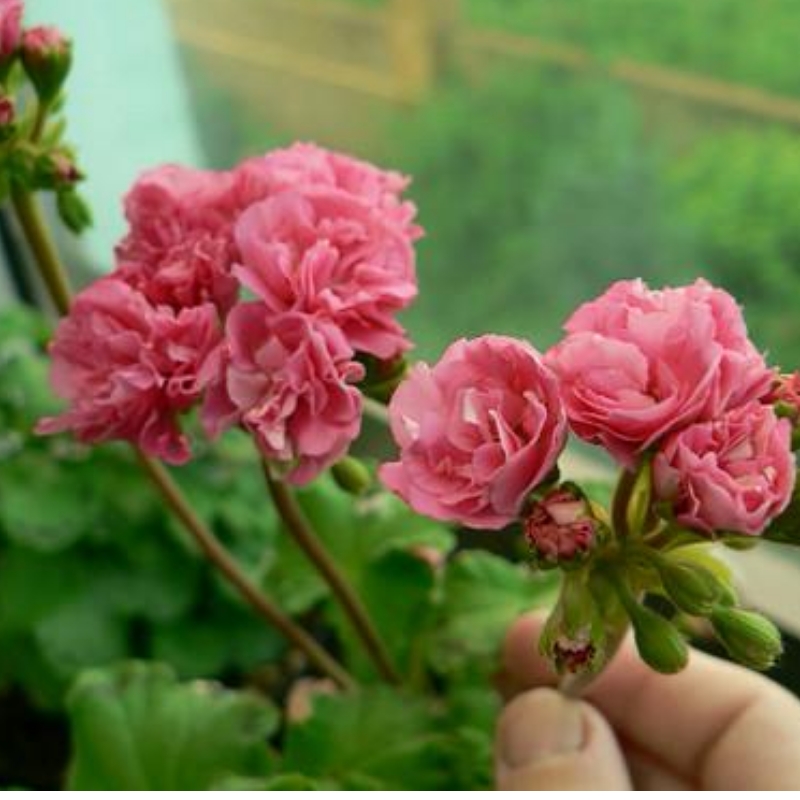
A beautiful flowering house plant that grows color even with infrequent maintenance. It is better to place the flower pot on the east or west side. It is enough to moisten the soil several times every 14 days.
Benefits:
- no special microclimate is required;
- aroma heals headaches.
Disadvantage:
- in order for geraniums to bloom profusely and for a long time, it is necessary to apply complementary foods once a month.
Aspidistra high
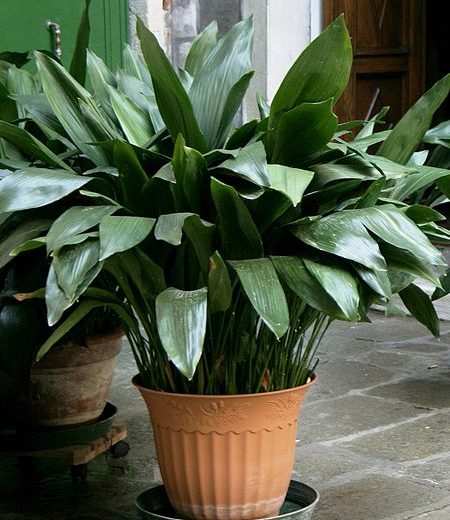
If you grow this plant only in the shade, then you should purchase aspidistra varieties with a pure green color.
Benefits:
- not demanding on the microclimate;
- subcortexes are rarely done.
Disadvantages:
- stagnant water is bad for the leaves;
- it is important to avoid direct sunlight.
Aglaonema is changeable
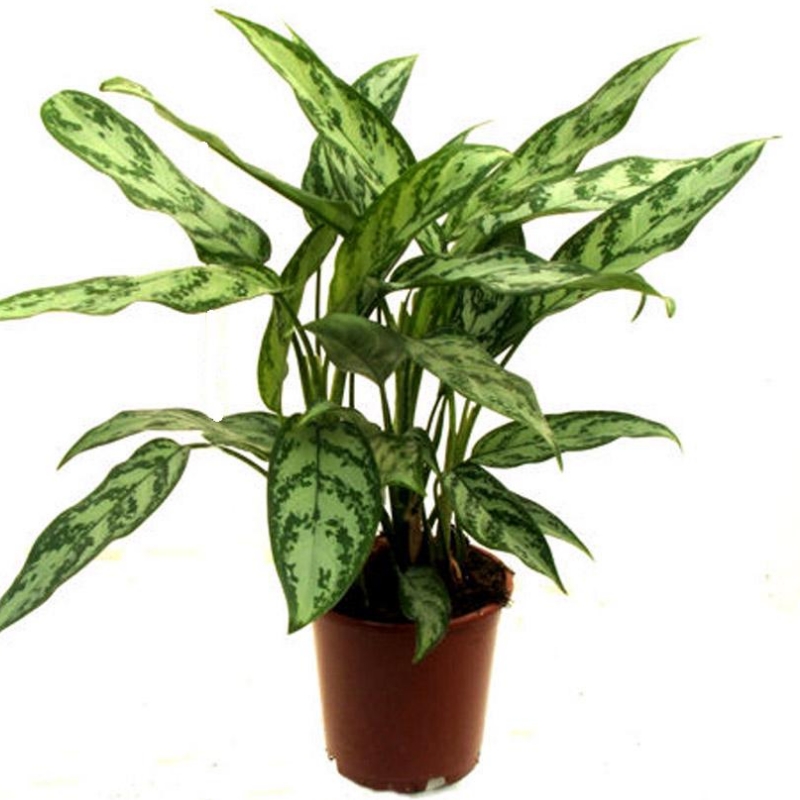
The indoor flower is varied in varieties and colors, from golden to gray shades.
Dense foliage creates a wonderful decoration of the room, unpretentious to the microclimate.
Benefits:
- able to grow in the darkest corners.
Disadvantage:
- it is necessary to carefully monitor soil moisture.
Gain color all year round
Among the shade-loving plants, there are plants that are capable of gaining color in the shade constantly; in the presence of bait, flowering can be abundant. Flowering plants are more demanding on the microclimate. For a reverent attitude towards themselves, they are presented with beautiful flowers that will decorate any corner of the apartment.
Male happiness - anthurium
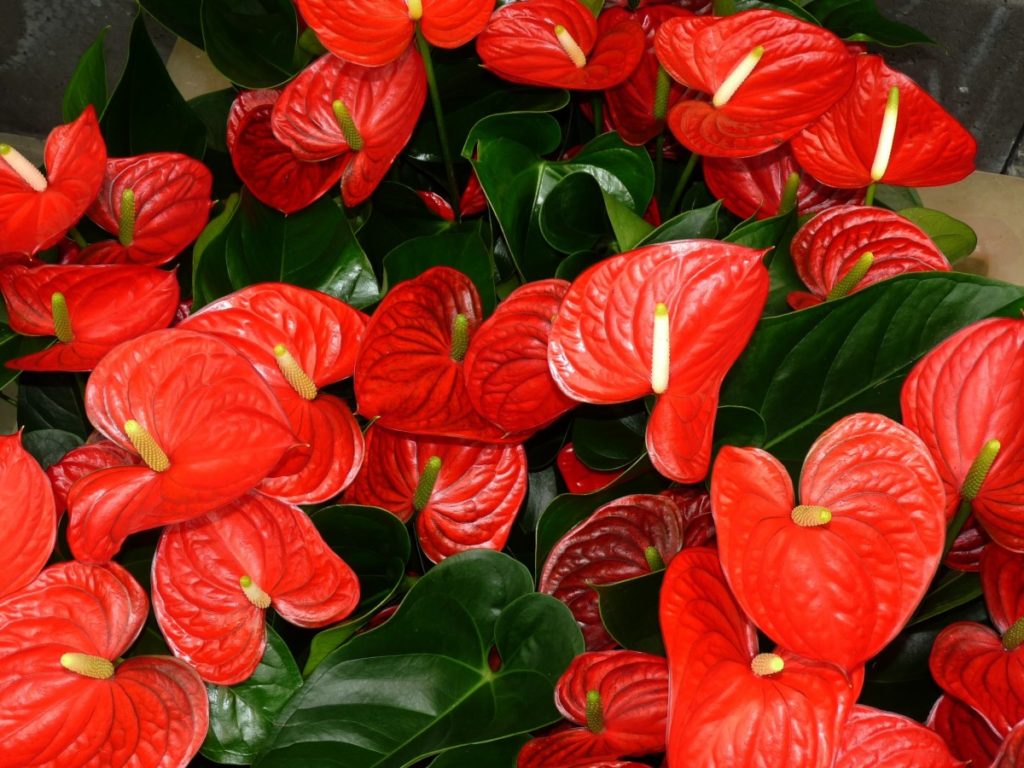
The atrium is considered to be a male power enhancer. Many are skeptical about this, but they still grow a flower in an apartment. Requires minimal travel costs.
Benefits:
- likes dark corners of the room, ultraviolet from direct rays is harmful, the sun can damage the leaves. If, nevertheless, it is placed near the window, then it is better on the east or west side;
- blooms beautifully without complementary foods.
Disadvantages:
- it is advisable to monitor soil moisture, dry land should not be;
- regular feeding will ensure uninterrupted flowering.
Pelargonium

A popular flower among fans of indoor floriculture. The plant can be placed in any corner of the room, in the shade the flower will stretch in height, in the sun it will grow in breadth.
Benefits:
- gaining color all year round and constantly.
Disadvantages:
- it is necessary to constantly maintain soil moisture;
- if you want to grow a neat bush, then you should constantly cut off the faded buds.
Begonia royal
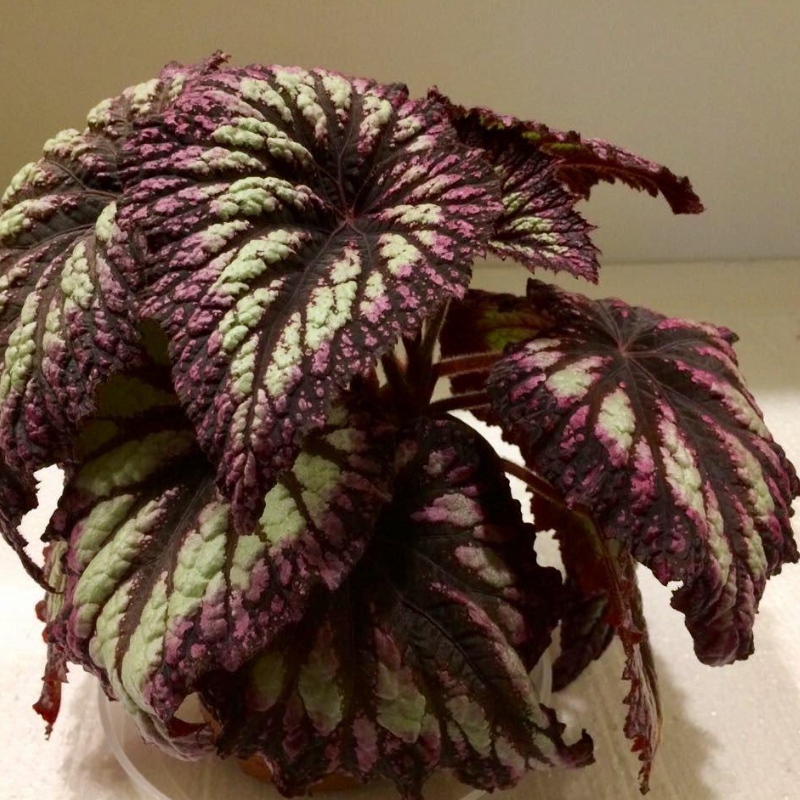
This begonia variety is suitable for those who plan to have flowering, unpretentious houseplants. The flower is undemanding to the place of residence, it only needs a little ultraviolet radiation for flowering.
There are many varieties of begonias, but flower growers prefer decorative royal begonias, since the lack of flowering is compensated by the presence of chic leaves of various colors.
Benefits:
- Gorgeous appearance even without flowering.
Disadvantages:
- loves abundant watering, but at the same time do not allow stagnation of moisture in the pot;
- trim the roots in time, as begonia can grow abundantly and take a long time to gain color.
Spathiphyllum
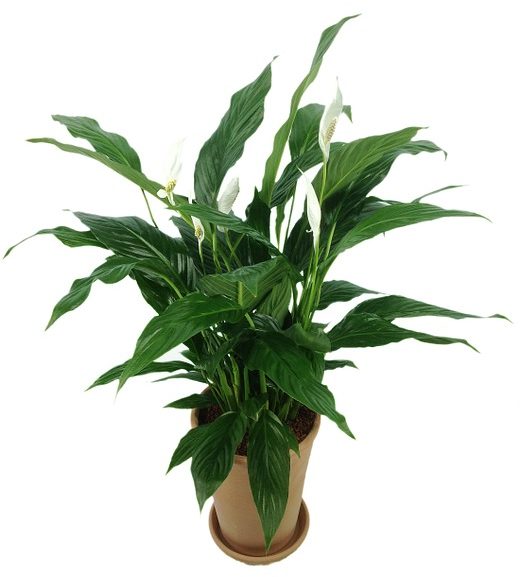
Indoor flower will appeal to lovers of feces. The plant develops white flowers, consisting of one petal. The flower should be placed in places where the sun's rays will not hit the leaves. Due to direct contact, foliage turns yellow quickly.
Advantage:
- flowering is more intense throughout the year in summer.
Disadvantage:
- you will constantly have to monitor soil moisture, otherwise flowering will disappear.
Kalanchoe
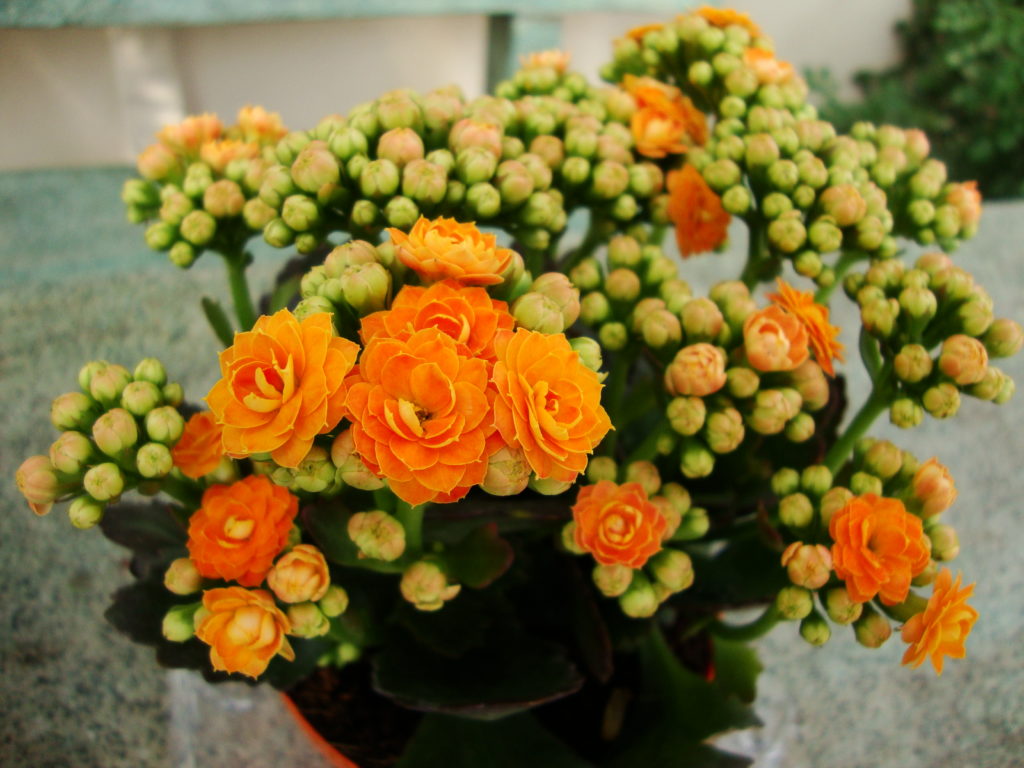
A flowering plant that loves summer. It is advisable to put in a semi-shaded place. Will decorate with flowering all year round.
Advantage:
- about Kalanchoe, you can not remember the month, even in dried soil it grows well.
Disadvantages:
- When forming seeds, the plant literally shoots them from the sides, which forces you to often clean up around the plant.
Chlorophytum
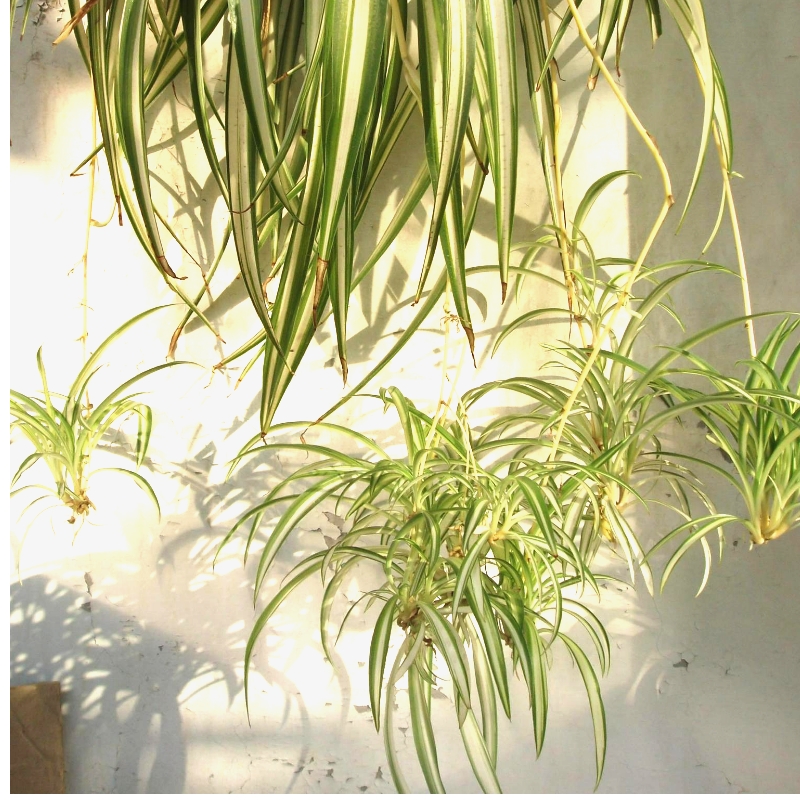
Suspended plant with pendulous processes. Perfectly decorate a wall in a room with poor light transmission. Resistant to changes in the microclimate in the apartment.
Advantage:
- the root system is designed in such a way that it collects water gradually, and within two weeks the flower does not need watering;
- does not need to create special microclimate conditions.
Disadvantage:
- so that the foliage of chlorophytum does not dry out quickly, spraying should be carried out constantly.
Alocasia
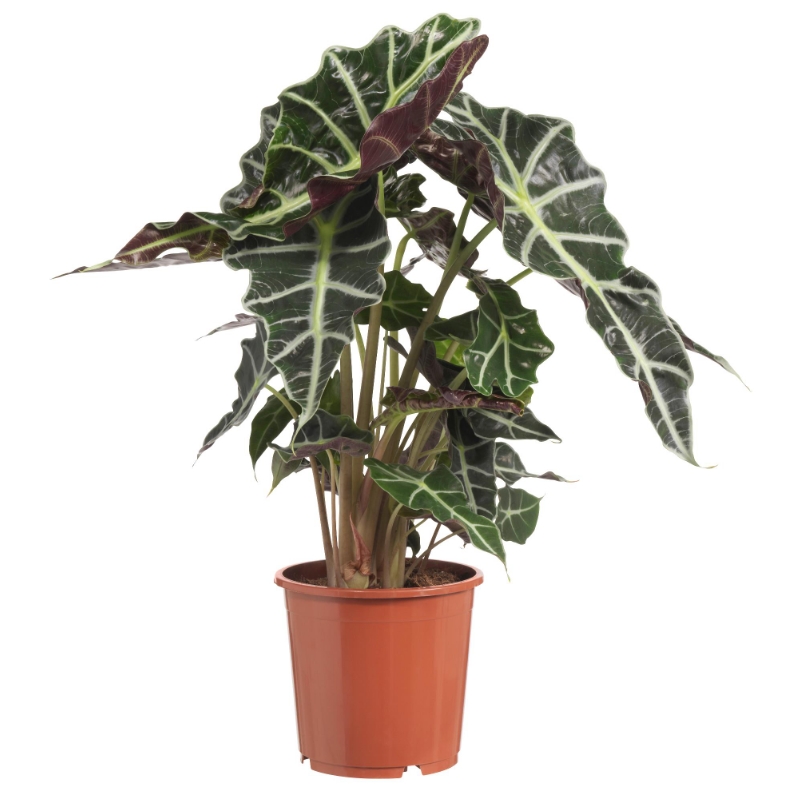
The plant can grow beautifully in the darkest corner of the apartment, while giving flowering. However, for the plant to live comfortably in the shade, painstaking work is required.
- First, it is planted in a special mixture, the ingredients of which resemble the soil for growing orchids;
- There should always be moisture in the soil. Therefore, a strict watering schedule is being developed.
Advantage:
- absolutely does not require light;
- can even bloom.
Disadvantage:
- picky about watering.
Epipremnum
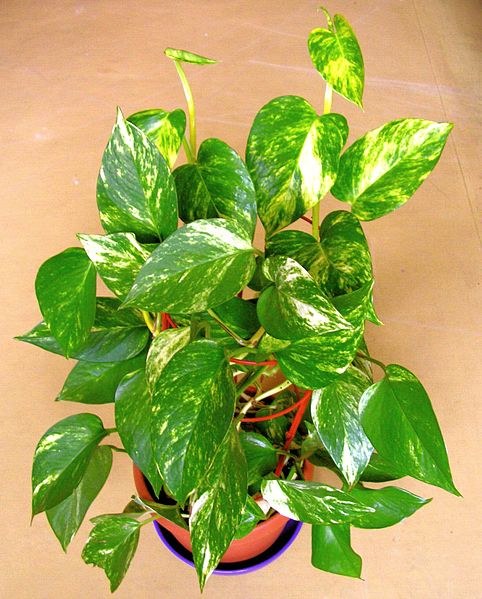
If you need to decorate the interior of an apartment with insufficient lighting, you should purchase an epipremnum. This climbing plant will perfectly decorate the room and does not require any expenses in its care. Withstands various microclimatic conditions. Grows up to 3 meters.
Benefits:
- soil moisture is rare;
- does not require feeding.
Disadvantages:
- in the complete absence of light, the foliage loses its mottling, while the decorative effect is preserved.
Indoor large-sized. Palm trees
You can diversify the interior or add a touch of exoticism to your home atmosphere using decorative palms or large trees. However, in most cases, this is a costly business and requires painstaking work to create special climatic conditions for the germination of exotic at home. Large trees and indoor palms do not tolerate frequent transplants and drafts. For those who have no time at all to look after and create proper care for such plants, it is recommended to purchase unpretentious varieties. There are several of the most popular types.
Hamedorea

The plant takes root in any home climatic conditions, does not require an excess of light and other factors, since it can grow under the proposed conditions.
Benefits:
- no need to think about a transplant, it is needed no more than once every 1-1.5 years.
Disadvantage:
- for the palm tree to gain growth, it is required to water intensively during a certain growth phase.
Hoveya Forster
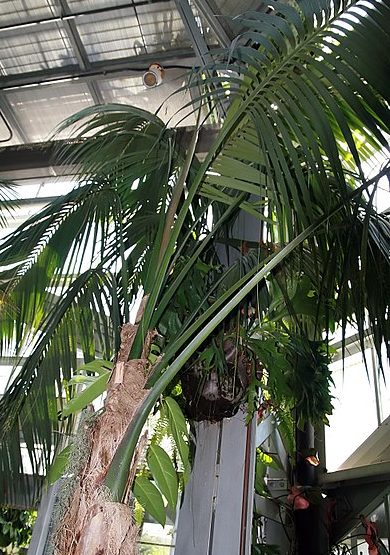
Outwardly, it has larger leaves and stems than chamedoria.
Advantages:
- unpretentious;
- can withstand drought.
Disadvantage:
- if growth is needed, then hoveu must be irrigated and fed constantly.
Dangerous house flowers
Some types of flowers can emit toxic substances to pets and can be dangerous to humans. Despite the warnings, many safely keep such plants at home.
- Philodendron (dangerous for cats, if an adult or a child eats a piece of the plant, minor side effects will appear);
- Syngonium (in humans and animals causes vomiting if you eat a piece);
- Spathiphyllum (the most dangerous type of flower, when it enters the stomach, it causes serious consequences);
- Dieffenbachia (causes mild symptoms of poisoning).
Fashionable shade-loving plants: how much does it cost to buy
Houseplants that love shade can be purchased at any specialty store. For the price, there are both inexpensive varieties and those whose average price is not affordable for everyone. Among the most popular types of shade-loving flowers are:
- Hamedorea
indoor palm tree with feathery leaves. Unpretentious in care, the only thing is to observe the thermal regime. Price: 300 rubles aisle.
Advantage:
- If you plant several palms together, you get dense thickets.
Disadvantage:
- You will constantly have to spray the foliage.
- Aucuba Japanese
A beautiful plant with a splash of gold on the foliage. Price: 400 rubles aisle.
Benefits:
- Does not require the creation of climatic conditions;
- Rare watering is possible.
Disadvantage:
- all parts of the plant are poisonous.
- Philodendron
A variety of vine that grows up to two meters in length. Perfectly decorate the interior of any apartment. Unpretentious care. Budget varieties can be purchased for only 100 rubles.
Benefits:
- This plant will adapt to any conditions.
Disadvantages:
- not.
- Epipremnum cirrus
It is more often found as a plant with lush foliage. The most popular flower among florists. Price: 250 rubles.
Benefits:
- tolerates dry air well;
- perfectly cleans the air from microbes in rooms.
Disadvantages:
- requires feeding and watering control.
How to choose a plant
To buy a flower that is necessary for specific conditions of existence, you should adhere to some points.
What to look for when choosing:
- remember that if unpretentious plants become the object of choice, they should still be cared for, even if minimal;
- it is worth purchasing plants only in special stores, the consultant will fully characterize and tell you how to care for the flower;
- clearly understand where you want to place the flower pot;
- when buying, pay attention to the general condition of the plant, it should be rich in color, without dry leaves and signs of disease;
- the condition of the soil should not be dry or too moist.
Plant safety
All types of domestic plants are prone to disease or pest damage. Some to a greater extent, some to a lesser extent.
It is imperative to carry out preventive measures:
- You should carefully examine the leaves of the flower from the outside and from the inside. This must be done when buying, as well as inspect the plants in the apartment once a week.
- The container for the plant and the bud during planting must be heated or frozen, depending on the selected species.
- You need to know how to create a microclimate for flowers that are at risk.
When parasites are found:
- Immediately isolate the plant from others, since pests spread very quickly;
- Collect pests by hand or wash off with a strong jet of water (repeat several times in a row);
- Wipe the leaves with a stiff brush dipped in soapy water.
- To combat persistent pests - wipe the leaves with a soft cloth with a solution of alcohol or denatured alcohol;
- You can wipe the leaves for a month with a decoction of garlic, hot pepper or onions;
- It is not recommended to carry out chemistry-based treatment at home, however, if there are a large number of pests, then phytoverm can be used. It effectively fights many types of pests, while being absolutely safe for humans and pets.
What house plant to choose
From the description of the most popular types of shade-tolerant plants, we can conclude that if you need a flower that you don't have time to care for, then you should choose unpretentious, little flowering plants. If they are able to give careful care, then flowering plants will delight all year round.
Where is the best place to plant a plant
For a children's room, it is better to purchase sansevieria and all types of indoor plants similar to it. Their advantages lie in the fact that they perfectly clean the air and do not require frequent wet cleaning of the leaves. Chlorophytum is also suitable for a nursery, which absorbs harmful substances from the air.
For a bedroom, it is better to dwell on Japanese fatsia, since at night it more actively produces oxygen and perfectly humidifies the air.
Plants that require a small amount of light should be placed in the kitchen. Popular blooming flowers for the kitchen are begonia. Its leaves give off essential oils, so it disinfects the indoor air.
Plants can be placed in the corridor that thrive in the darkest corners. Curly shade-loving flowers are suitable for decorating the corridor, the most popular are:
- Chlorophytum;
- Epipremnum;
- Tradescantia.
Choosing the right plant will decorate the space even where access to natural light is completely excluded.It is important to follow the rules of caring for the selected flowers.


